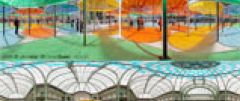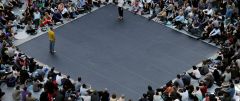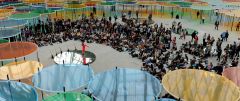The devices of Excentrique(s), work in situ
Device no. 1
The usual entrance by the main door to the nave of the Grand Palais is replaced by a new entrance through the north door.
Device no. 2
The north door is redesigned to take visitors directly into the nave through a long, square, relatively dim corridor, lit only by two rows of LED lights along the foot of the walls. Its entrance is on the footpath itself, signalled by a large black and white striped porch.
Device no. 3
Device no.3A:
A ticket office specially designed for this event is set up near the Champs-Élysées-Clemenceau Metro station. It is shaped like the main installation inside the nave, but is in different colours.
Device no.3B:
Arrows painted on the ground lead visitors to the porch described in no. 2.
Device no. 4
An aggregate of circles in five different sizes (from 2 to 6.5 m in diameter), linked tangentially one to another to form a sort of suspended carpet, fills as much of the nave as permitted by safety regulations, i.e. approximately 8.500 square metres.
The circles are covered with transparent coloured plastic film and supported by tubular legs (9 x 9 cm section) in varying numbers depending on the diameter of each circle. These posts (1,300 in all) give the impression of a forest, originally black and white, but transformed by the light shining through the coloured circles.
The plastic film is in four colours (the only colours available for this material): pale blue, golden yellow, orange and soft green. These colours are positioned so that they are spread over the whole surface in equal proportions: 95 blue, 94 yellow, 94 orange, and 94 green circles, making a total of 377. There is an extra blue circle at the end, as if to start the next cycle.
The coloured circles are placed at a height of 2.5 to 2.9 m. The empty spaces between them are used to adjust the entire device visually and to give access to the circles if they need cleaning (to remove pigeon droppings, for example).
Device no. 5
The “carpet” stops suddenly directly below the central dome. This circular hole in the “forest” of legs is like a clearing in the woods. It is roofless, approximately 32 m in diameter and covers an area of nearly 900 square metres.
Device no. 6
Circles of mirror glass, of the same diameter as the coloured circles, are arranged inside this “clearing” on podiums 17 cm high. Visitors can walk, sit or lie on them. They reflect fragments of the central dome and therefore device no. 7.
Device no. 7
The central dome is made of concentric circles, the edges of which touch the beginning of the steel pillars that support the whole structure. The skylight is partly covered by blue filters forming a large coloured “checkerboard” more than 40 m above the visitors’ heads.
When the sun comes out, all these colours (on the dome and on the circles in device no. 4) are projected on the ground, on the steel poles, on the rings holding the filters, on the mirrors and, of course, on the visitors passing from one colour to another. Depending on the angle of the sun, the colours sometimes mix to make new colours.
Device no. 8
Inside the aggregate of circular cells are three different elements, with specific functions, designed by Patrick Bouchain and Loïc Julienne.
Device no. 8A:
Near the north entrance, one of the cells is used as a reception desk to inform visitors.
Device no. 8B:
further along in the west part of the nave, nineteen different cells are used for a café-restaurant which can seat a hundred people.
Device no.8 C:
Near the exit (the south door), a set of five adjacent cells forms a bookshop.
These three devices are constructed mostly from white painted wood, with specific LED lighting for use at night.
The white walls are constantly transformed by the reflection of the coloured circles, which form its ceiling and roof, depending on the tilt of the earth in relation to the sun, the clouds, time of day, etc.
Device no. 9
Round white wooden benches for visitors to sit on are dotted along the circuit.
Device no. 10
Electric lighting is used at night. The light fittings are attached to a technical bridge around the perimeter of the central dome, 35 m above the ground. Computer-operated spotlights move up and down and left to right independently of one other. They send intermittent waves of light over all the devices below.
Device no. 11
Sound is an important part of this work: voices read out the figures underlying the construction of the main device, the initials of the four colours in alphabetical order plus black and white, and then the names of those colours.
The texts are read by 37 people in 37 different languages from all over the world.
The original soundtrack was mixed by Alexandre Meyer.
The soundtrack is broadcast by highly directional mobile speakers, computer-programmed so that visitors go through waves of sound which come and go, stop and start, and change language from one sound zone to the next.
Daniel Buren
Paris, 5 March 2012





